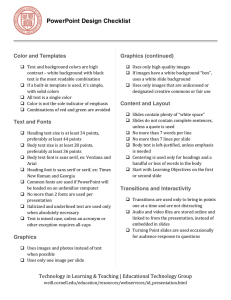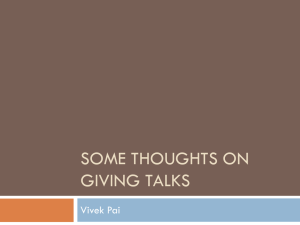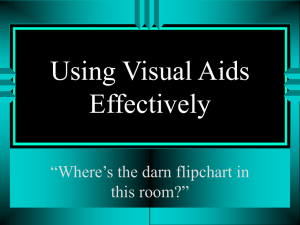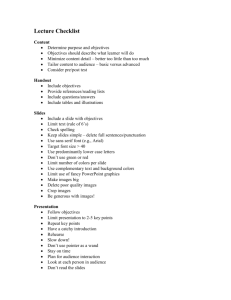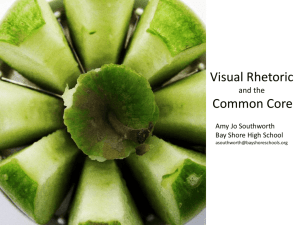How to prepare a presentation and give a talk
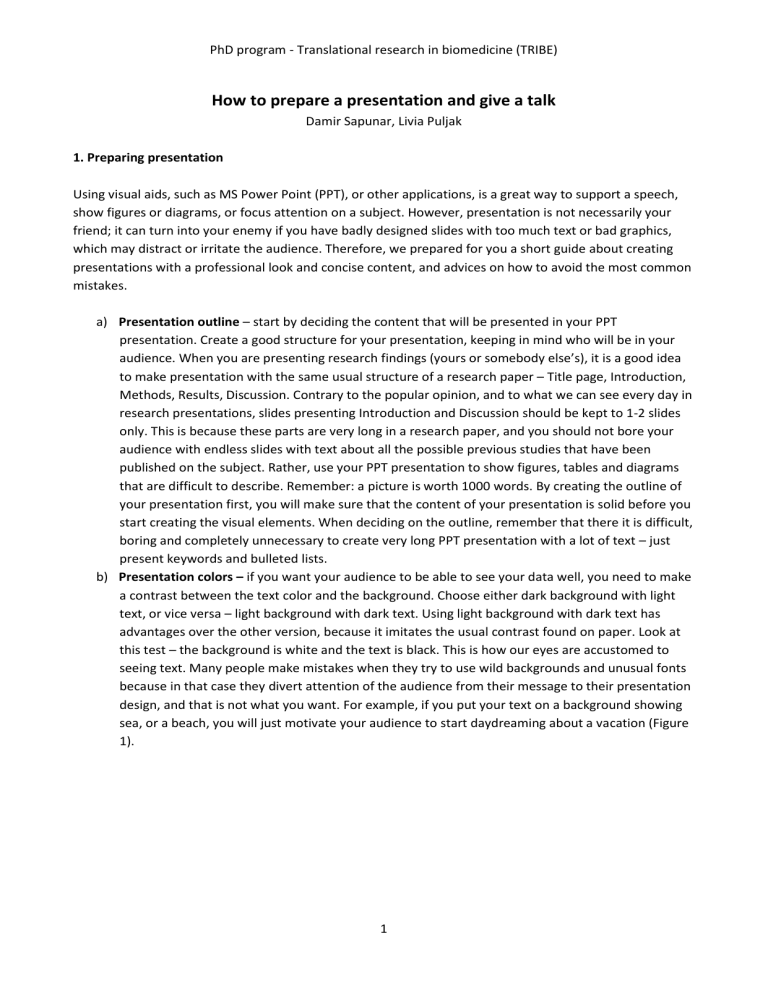
PhD program - Translational research in biomedicine (TRIBE)
How to prepare a presentation and give a talk
Damir Sapunar, Livia Puljak
1. Preparing presentation
Using visual aids, such as MS Power Point (PPT), or other applications, is a great way to support a speech, show figures or diagrams, or focus attention on a subject. However, presentation is not necessarily your friend; it can turn into your enemy if you have badly designed slides with too much text or bad graphics, which may distract or irritate the audience. Therefore, we prepared for you a short guide about creating presentations with a professional look and concise content, and advices on how to avoid the most common mistakes. a) Presentation outline – start by deciding the content that will be presented in your PPT presentation. Create a good structure for your presentation, keeping in mind who will be in your audience. When you are presenting research findings (yours or somebody else’s), it is a good idea to make presentation with the same usual structure of a research paper – Title page, Introduction,
Methods, Results, Discussion. Contrary to the popular opinion, and to what we can see every day in research presentations, slides presenting Introduction and Discussion should be kept to 1-2 slides only. This is because these parts are very long in a research paper, and you should not bore your audience with endless slides with text about all the possible previous studies that have been published on the subject. Rather, use your PPT presentation to show figures, tables and diagrams that are difficult to describe. Remember: a picture is worth 1000 words. By creating the outline of your presentation first, you will make sure that the content of your presentation is solid before you start creating the visual elements. When deciding on the outline, remember that there it is difficult, boring and completely unnecessary to create very long PPT presentation with a lot of text – just present keywords and bulleted lists. b) Presentation colors – if you want your audience to be able to see your data well, you need to make a contrast between the text color and the background. Choose either dark background with light text, or vice versa – light background with dark text. Using light background with dark text has advantages over the other version, because it imitates the usual contrast found on paper. Look at this test – the background is white and the text is black. This is how our eyes are accustomed to seeing text. Many people make mistakes when they try to use wild backgrounds and unusual fonts because in that case they divert attention of the audience from their message to their presentation design, and that is not what you want. For example, if you put your text on a background showing sea, or a beach, you will just motivate your audience to start daydreaming about a vacation (Figure
1).
1
PhD program - Translational research in biomedicine (TRIBE)
Figure 1. Tropical beach and palm trees: This will be a great PPT background only if you want to lose attention of your audience and send them off mentally to a far-away beach a) Avoid animations – these are disturbing for the audience. You want your audience to read the text, but if the text is moving on the screen in any way, it makes harder for the audience to read it. It also prolongs the presentation, because the presenter needs to wait for the text to come in. The only animation that is acceptable is the “Appear” effect, which just makes the text appear, and is the easiest for the audience to read. b) Avoid sound effects – you may use these only once, in a place that is really important and you would like to emphasize it. Otherwise, it becomes too disturbing for the audience. c) Presentation font size – use large font so that the audience can read it. Do not use fonts smaller than 24 point, because that will be too small to be reasonably read in most presentation situations.
It is preferable to use text at a 28 or 32 point size, with titles being 36 to 44 point size. It is different when you look at the text on your computer, and when you look at it in the large room on a small projecting screen. d) Presentation font type – use font types that are easy to read, clear at any size and helpful for moving your eye through the material. The simple serif and sans serif fonts fall into this category.
What is a ‘sarif’ or ‘sans serif’ font? The characters in some fonts have little feet on each character, like the characters in Times New Roman font. These are serif fonts. Fonts that do not have these little feet or lines are called sans serif fonts, and an example of these is Arial (Figure 2).
Figure 2 : An example of a serif (Times New Roman) and sans serif (Arial) font
2
PhD program - Translational research in biomedicine (TRIBE)
Avoid UPPER CASE LETTERS, because in electronic text they are equivalent to shouting. Also, avoid underlining, italics and bolding (Figure 3).
Figure 3 . Use elegant and light fonts, avoid upper case letters, underlining, italics and bolding e) Keep the amount of text to a minimum – there are various recommendations. Some suggest using standard rule 7x7, which recommends using no more than 7 words per line and 7 lines per slide.
Others suggest even less text. The most extreme suggestion that we have come across is to use no more than 6 words on a slide. All these recommendations basically suggest that the amount of text on a slide should be kept to a minimum, because audience is not there to read, the audience wants to hear a presentation from you, and PPT presentation is only an assistant, not the main player in your talk. f) KISS – keep it short and simple. Use only keywords, not the full sentences. g) Use visuals, not text – the point of your talk is to send a message, and you will achieve this with visuals (figures, diagrams) much more effectively than with any amount of text h) Be consistent with the presentation design - Consistently use the same font face and sizes on all slides i) Do not be silly – if you really want to use some humor, cartoons and clip art, do it sparingly, only on one slide, do not exaggerate, otherwise you will not send a serious message to your audience. j) Practice – know your slides, speak freely, speak loud and clear with confidence, do not speak too fast and maintain eye contact with the audience. It is really boring when the presenter looks only at the slides and avoids eye contact with the audience like a plague.
Figure four will repeat this all and list once more things that you need to avoid.
3
PhD program - Translational research in biomedicine (TRIBE)
Figure 4 . Recipe for PPT disaster
How many slides should there be in your presentation?
Contrary to the popular opinion that you can have as many slides as you want, the number of the slides is limited with the allotted time. If you are supposed to give a 10-minute talk, you cannot have 30 slides, because you simply do not have time to show them all, and to explain every slide properly. Here is a simple rule that may help you – have the same number of slides as the number of minutes that you are supposed to talk, plus 2 – for the first slide and ‘thank you’ slide. The first slide is always a title-slide, which contains title of the presentation, name of the presenter and, if you want, date and place of the talk. The last slide should be a ‘thank you for your attention’ slide. For example, if you need to give a 10-minute presentation, you should not have more than 12 slides, and among those slides two are the ‘first’ and ‘last (thank you)’ slide. Everything more will just create unnecessary problems because your time will expire, and your entire message will not be delivered. Most of the time we are expected to give short presentation, and there you need to be really careful what information you will put in your PPT slides. Sometimes, however, you will have a lot of time. If you have a 60- or 90-minute talk, do not be tempted to put hundreds of slides either.
Use them sparingly because your audience can absorb a limited amount of information.
4
PhD program - Translational research in biomedicine (TRIBE)
2. Presenting – giving a talk
The language
Use simplified English, neutral and understandable as possible, without colloquial idioms, regional expression and any other source of linguistic confusion.
Dos and Don'ts
- Don't speak to fast or too slow.
- Don't say "sorry for this slide"
- Don't read your slides, explain them!
- Don't read your presentation from a script
- Don't turn your back to the auditorium
- Don't circle with your pointer
- Do structure your presentation so that you convey a few clear messages instead of a huge amount of notso-relevant information that nobody has a chance to take in.
- Do avoid anything that would make you nervous (turn off your cell phone).
- Hold your pointer with both hands
Introducing the Presentation
- Good afternoon. It's an honor to have the opportunity to speak to you about…
- Good afternoon. Thank you for your kind introduction. It is my pleasure to speak to you about an area of great interest to me.
- In the next few minutes I will speak about…
- The topic I'll cover this afternoon is…
- I'd like to thank Dr. XY for his kind invitation.
- It is a great honor to be here talking about…
- What I want to talk about this morning is …
- During the next few minutes I would like to draw your attention to..
Commenting on images, graphs, tables…
- As you can see in the image on your right…
- As you will see in the next table..
- The next image shows…
- To sum up, let's look at this diagram…
Technical problems
Do not have technical problems. Prepare and test everything in advance.
- May I have another laser pointer.
- Can we turn of the lights please?
- My presentation is not running properly. In the meantime I'd like to comment on…
5
PhD program - Translational research in biomedicine (TRIBE)
Summing up
- Let me summarize the content of my lecture…
- To sum up we can say that…
- To conclude…
- The take-home message of the talk is…
- To put it briefly…
Concluding
- Thank you for your kind attention.
- Thank you very much for your time.
- Thank you for your time. I would be happy to address any questions.
- Let me finish my presentation by saying that…
- Let me end by wishing you a pleasant stay in our city.
- I'd be happy to address your comment and questions.
Discussion and questions
There are several types of questions: a) Someone wants to know particular detail of your presentation.
These questions are easy to handle by just answering the question. b) Someone who wants the audience to notice his knowledge of the subject which is being discussed.
Possible answers:
- I agree with your comments.
- We are planning to include this point in our next study. c) Someone who strongly disagrees with your points.
- I will consider your suggestion on…
- This is a work in progress and we will consider including your suggestions…
- With all respect, I don't go along with you on…
- I strongly disagree with your comment on…
- I don't see a valid argument for supporting such a comment…
- I don't think we have enough time to discuss your comments in depth.
Incomprehension:
- I'm not sure I understood your question
- Sorry, I don't quite follow you
- Would you repeat the question?
- I'm afraid I still don't understand.
Do not use this:
- I'm glad that you asked that question.
- That is excellent question
Remember: Chairman can always help you
6
PhD program - Translational research in biomedicine (TRIBE)
Chairman’s introduction and closure of the presentation
Introducing the session
- Our first speaker is Ms. XY from Split , who will present the paper "XX"
- Our next lecturer is Dr. XY from Split and her presentation is entitled "XY"
- Dr. XY is the next and last speaker. Her presentation is "XY"
Closing the presentation
- Thank you for your excellent presentation. Any questions or comments from the audience?
- I would like to thank you for this excellent talk. Any comments?
- Thanks a lot for your talk dr XY. I wonder if the audience has any questions?
Closing the session
- I'd like to thank all the speakers and the audience for your interesting presentations and comments.
- The session is over. I want to thank all the participants for their contribution.
7
